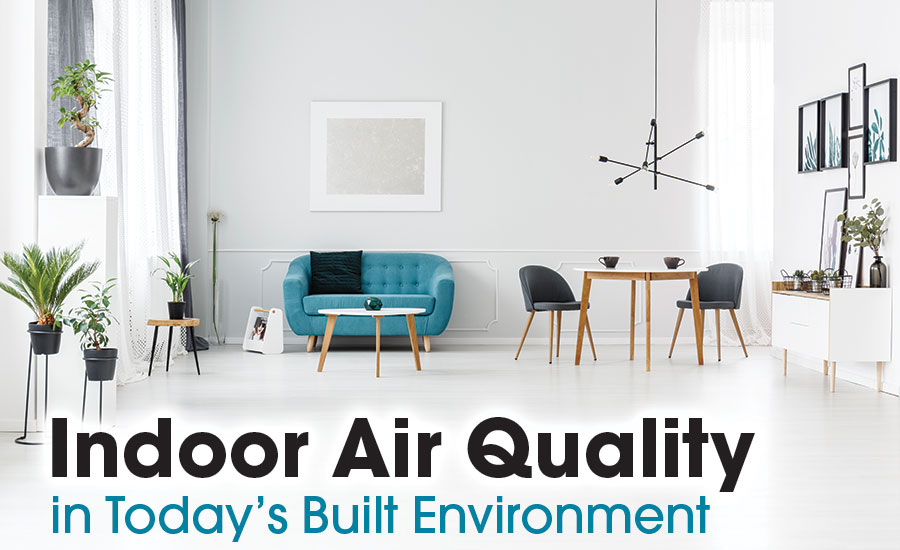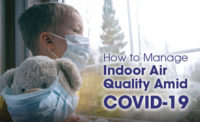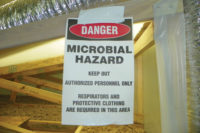Indoor Air Quality in Today's Built Environment
New tools for tackling IAQ problems.

For decades, scientists have been focused on outdoor air quality. Today, there are regulations in place across the U.S., and around the world, to help keep the atmosphere clean, and reduce smog and other pollution.
As the built environment in which we live our lives evolves and changes, so does the battle against mold and ques-tions loom about indoor air quality. While every state is different, California has some of the most intensive regulations in place for air quality control, creating the California Air Resources Board, which breaks the entire state down into 35 local air districts. Much of the push for cleaner air has come with a push for increased energy efficiency and less reliance on fuels and substances that can harm the atmosphere. Today, we are seeing a shift toward making buildings efficient as well for the sake of both the exterior and interior air quality.
In the name of energy efficiency, our buildings today do not breathe as they once did. Instead, we live our lives in environments of filtered air – through a heating or cooling system. The American Society of Heating, Refrigerating, and Air Conditioning Engineers (ASHRAE) recommends we bring some outdoor air inside, but that does not always happen, which has some IAQ firms taking a closer look at the indoor air. A 2004 study by the International Centre for Indoor Environment and Energy in Denmark said:
“The main justification for ventilation has historically been to create a healthy indoor environment. Ventilation removes air pollutants originating inside the building, including bio-effluents. The outdoor air supply rate that has been found by experience to provide subjectively acceptable indoor air quality and to prevent the accumulation of moisture in the building is generally sufficient to maintain the concentration of pollutants at healthily low levels. Until [1999], this would have been the justification for current ventilation practices, but in 1999 the first of a series of experiments was published, revealing new mechanisms by which raised levels of indoor air pollution may reduce productivity, either in addition to or instead of having negative effects on comfort and health.”
That study goes on to talk about how indoor air quality has a direct, proven effect on worker performance and productivity, and offers solutions to overcome the IAQ issue, including potentially increasing outdoor air supply rates to foster a better balance inside.

Photos courtesy of Goldmorr USA
IAQ & Remediation
In the restoration and remediation industry, these IAQ issues translate into moisture and mold issues that involve not only a remediation plan, but also getting to the root cause of the issue. Because indoor air quality is not regulated like the air we breathe outside, the built environment can be a bit of a wildcard. Michael Pinto, Dr. Steve Froelicher, and countless other indoor air quality experts directly plugged into the remediation industry have written numerous articles for Restoration & Remediation in recent years about the importance of improving IAQ, and being cognizant of the effects of mold-related illnesses, which stem from the indoor environment.
On top of research and articles from industry experts, a number of restoration industry companies are taking steps to provide tools and resources for IAQ issues. The use of particle counters for IAQ testing has grown tenfold, especially in the realm of forensic restoration. Dr. Bob Moore, the chief science officer at IAQ Analytics in Melbourne, Australia, the parent company to the Goldmorr System for mold remediation, has focused recent research on questioning if the energy efficiency debate is being waged at the expense of optimal air quality for breathing.
“If there is no other reason to ventilate buildings, we need oxygen to breathe, and accordingly airtightness as a goal of the building industry, is questionable as a one-size-fits-all approach, even when it saves on energy bills,” Dr. Moore explained. “It has been argued that the inside air comes essentially from outside, but there is also an argument that the indoor air is a special flow of its own, and that what is creeping under the door is only gases exchanging, not so much particles.”

Photos courtesy of Goldmorr USA
You are right if you are thinking a lack of air coming in from outside isn’t the only issue in today’s built environment. We are also dealing with a slew of different chemical compounds in buildings and contents, each of which are evolving and changing at breakneck speed. Therefore, it can be difficult to tell where the environmental irritants are coming from without proper testing and protocols.
“Chemical compounds are present in indoor air as well as outdoors. It’s just a question of amount, and guidelines do exist on what are normal or tolerable amounts. Chemicals may come from the off-gassing of flooring materials, paints and furniture coverings, even plastic building materials,” Dr. Moore said. “So rather than all chemical and biological constituents of air coming from the outside, some can actually be getting generated indoors itself. In fact, even molds can produce chemical toxins, while the spores themselves are larger.”

Photos courtesy of Goldmorr USA
According to IAQ Analytics, “Particulates within the air are generally measured in 6 sizes, with the 5 micron size being the most relevant to mold.” Without getting into the nitty gritty of particle sizes, which you can read about in some other past articles in R&R, it is critical that restorers understand the importance of air quality testing before, during, and after remediation. This is where an IAQ testing company steps in. Technicians can take readings and compare them to the International Standards Organization (ISO), or reference acceptable particle levels from the World Health Organization (WHO). Doing air quality testing can offer valuable information about the remediation needs in the home or business where you are working, and allow you to address problems the property owner may not have known existed in the first place.
Sources:
https://www.ncbi.nlm.nih.gov/pubmed/15330777
https://sourceable.net/mould-spores-and-indoor-air-quality-ventilation-and-particle-distribution/
Looking for a reprint of this article?
From high-res PDFs to custom plaques, order your copy today!






